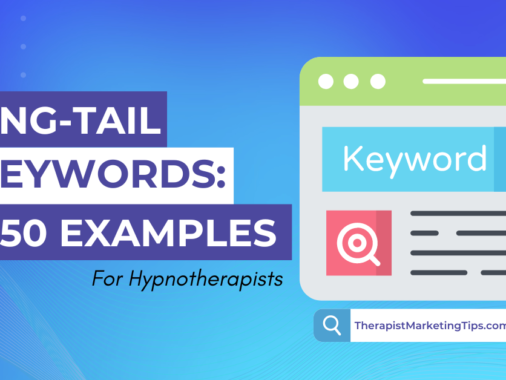In the world of local SEO (Search Engine Optimization), NAP stands for Name, Address, and Phone Number. NAP Consistency, therefore, refers to the process of ensuring that your business’ vital contact details remain consistent and accurate across the web.
In this guide, I’ll outline why this process is so essential for optimizing your online presence to attract more clients.
I’ll also provide you with top tips, tools, and strategies to maintain NAP consistency for your therapy practice, and even share with you my favorite NAP consistency checker to help you keep on top of your expanding digital identity.
What is NAP Consistency, and What Does it Include?

Although NAP stands for Name, Address, and Phone number, it doesn’t just refer to those three key pieces of information about your business.
It also includes your:
- Website address (URL)
- Email address
- Social media Profiles
- Business hours
- Business descriptions and bios
- Logo and branding
- Photos and images.
In other words, all the information that potential clients would use to learn about your therapy practice and get in touch with you.
Although not the most glamorous part of SEO, keeping all this information consistent across each of your online profiles is essential.
When you think about it, it’s easy to see why:
As your practice grows, you begin to use more and more marketing channels to attract clients.
Perhaps you start off by creating a Facebook page while waiting for your website to be ready.
Once your website is live, you continue to expand your digital reach by creating a Google My Business profile, establishing a presence on half a dozen therapist directory sites, and starting a therapy practice Instagram account.
The more profiles you create, the greater the risk of placing inaccurate and inconsistent information about your business on the web.
To demonstrate how this might affect you, let me share a hypothetical scenario:
Dr. Sarah’s NAP Inconsistency
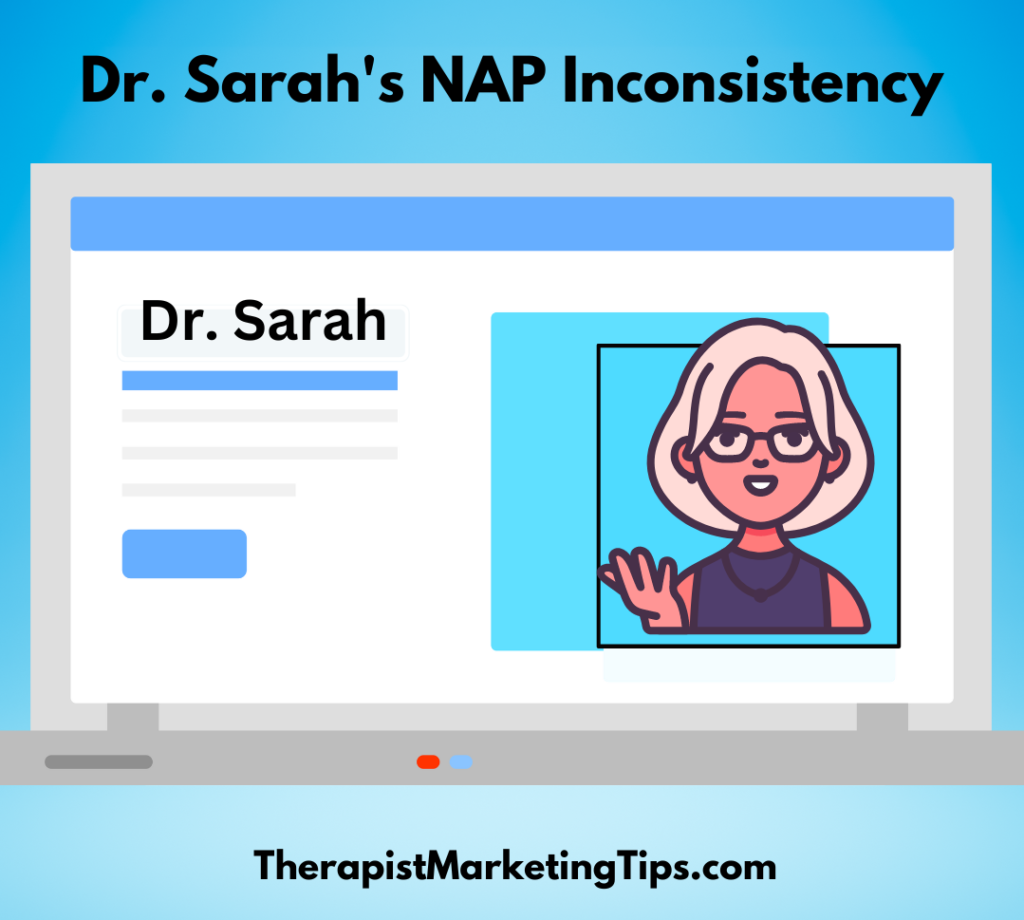
Dr. Sarah is a respected therapist with a growing practice. As her therapy practice expands and she establishes a presence on various online platforms, the importance of NAP consistency becomes evident.
Facebook Page:
Dr. Sarah starts by creating a Facebook page for her therapy practice. She uses her full name, “Dr. Sarah Johnson,” as the page name and provides her office address and contact number.
Google My Business (GMB) Profile:
As her practice gains momentum, Dr. Sarah claims her Google My Business listing. However, she uses a slightly different version of her name, “Dr. S. Johnson,” and accidentally omits her office number.
Therapist Directories:
To expand her online reach, Dr. Sarah joins several therapist directories. In one directory, she uses her full name, “Sarah Johnson, Ph.D.,” while in another, she goes by “Dr. Sarah J.” These discrepancies confuse potential clients and search engines alike.
Website and Email:
When Dr. Sarah started her practice, she used a free email address: drsarahjohnson@gmail.com.
However, Sarah then launches a new website with a professional email address, info@sarahjohnsontherapy.com, which she prefers to use. The only problem is she forgets to update her email address on the profiles she’s already created, which still show her Gmail account.
Ultimately, this means inquiries get lost.
Phone Number:
When Dr. Sarah started her practice, she was using her personal phone to take business inquiries. She later switched to a dedicated business line but, again, neglected to update her new contact details across the web.
Social Media Profiles:
Half of Dr. Sarah’s social media handles are @DrSarahJ, but her Instagram account is @therapistdrsarah. This results in a mix-match of her social media presence, which can confuse people looking to follow her across multiple platforms.
Already, you can see where Dr. Sarah’s NAP inconstancy could be costing her clients, but that’s not the only reason why it’s important to maintain consistent Name, Address, and Phone number details across the web.
Here are a few more reasons.
Why is NAP Consistency Important?
Apart from losing out on inquiries due to out-of-date contact details, failing to maintain consistent NAP information across your online presence could also be harming you in other areas too:
Local SEO and Search Rankings
Search engines, especially Google, consider NAP information to determine the legitimacy and relevance of a business.
If Google doesn’t consider your practice legitimate, it simply isn’t going to prioritize you in search results, meaning reduced online visibility, fewer visitors to your online profiles, and in turn, fewer clients.
By maintaining consistent NAP details across various platforms, you signal to search engines that your therapy practice is trustworthy and genuine.
This can positively impact your local search rankings, making it easier for potential clients to find your practice when searching for therapy services in your area.
Client Trust and Credibility
Inconsistent NAP information can erode trust in your therapy practice. Potential clients may view conflicting details as unprofessional or unreliable, leading them to seek services from other therapists with more consistent information.
On the other hand, a cohesive and reliable NAP profile instills confidence in potential clients, showing them that your practice is legitimate and committed to delivering quality services.
Client Confusion and Misunderstanding
Even if your inconsistent details don’t harm your reputation, they could cause an equally sizeable problem:
Confusing clients as to whether you’re the person they’re looking for.
Is the Dr. Sarah on Facebook with the five-year-old profile photo and a Gmail address the same therapist as the one on DrSarah.com with the updated photo with a completely different hairstyle and a @drsarah.com email address?
Is John The Therapist based in Lord Street, Manchester on Google the same John The Therapist listed in Canal Street on CounsellingDirectory.com?
It may not be so easy to tell, and if clients can’t tell whether you’re the person they’re looking for, they may give up the search altogether.
Brand Consistency
Maintaining a consistent NAP across different platforms helps reinforce your therapy practice’s brand identity.
Consistency in contact details, branding, and imagery creates a unified and professional image, making your practice easily recognizable and memorable.
How to Maintain Consistent NAP Information

1. Create a Master Document
Compile all your current NAP information in a master document.
This document should include all the following:
- The name of your practice
- Business address
- Phone number
- Website URL
- Social media profiles
- Business hours
- Any other relevant details pertinent to your practice.
2. Carry Out a NAP Audit
A NAP audit is exactly what it sounds like:
Conducting a thorough audit of all your online profiles, including your website, social media accounts, therapist directories, and anywhere else where you may have an online presence.
As you do so, compare the details listed to those in your master document. Take note of any outdated, inaccurate, or inconsistent details you come across.
Later in this guide, I’ll share some nap consistency tools you can use to make this process easier.
3. Use a Standard Format Across the Board
Adopt a consistent format for presenting your NAP details. Whether it’s abbreviations, punctuation, or phone number formatting, stick to the same style across all platforms.
4. Claim and Verify Listings
Claim ownership of your business listings on popular directories and review sites.
This gives you control over your NAP information and allows you to update it as needed.
5. Check for Consistency in Social Media Handles
Check the usernames or handles you’ve chosen for each platform.
Ideally, try to use the same or similar handles across all platforms to maintain consistency. For example, if your therapy practice is named MindBalance Therapy, you could use @MindBalanceTherapy as your handle.
Having the same social media handle across all platforms ensures NAP consistency by presenting a unified and recognizable online identity for your therapy practice. This consistency enhances brand recognition, simplifies client engagement, and reinforces professionalism, ultimately contributing to a strong and cohesive online presence.
6. Update Changes Promptly
If your therapy practice undergoes any changes, such as moving to a new location or updating your phone number, make sure to update this information across all platforms as soon as possible.
7. Train Your Team
If you have a social media manager, assistant, or anyone else who plays a role in promoting your practice, ensure they understand the importance of NAP consistency (perhaps by sharing this article!) and have access to your master document so that they know the correct information to use.
8. Regularly Review and Revise NAP information
Carrying out a NAP audit is not a one-and-done thing. As your practice evolves, things may change. That’s why it’s so important to regularly review Name, Address, and Phone number information to find and fix any discrepancies.
Top 3 Best NAP Consistency Checker Tools
Before I share these useful NAP consistency tools with you, I should point out that most of them don’t refer to NAP, instead referring to terms like “local citations” and “local listings.”
For the sake of what we’re doing here, you can think of both of these terms as referring to any online reference of your business, such as on business directories and social media.
What each of these tools does is scan the web to find any and all mentions of your business and highlight any discrepancies in your NAP details.
1. My Top Pick: BrightLocal Citation Tracker
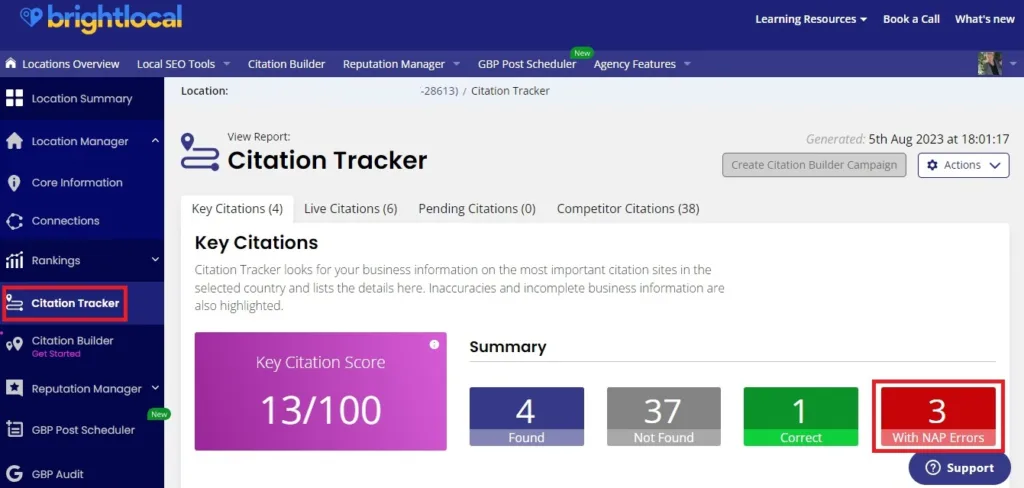
BrightLocal has a bunch of interesting Local SEO tools that are well worth a look, but for today, I just want to concentrate on their NAP consistency checker.
Enter the name and general location (by city or zip/postal code), and let the platform do its thing.
Although the frustrating part is that BrightLocal is by far the slowest NAP checker I’ve used, the results are very good.
First, you get an overall Key Citation Score based on both the quality and quantity of your online listings.
The more error-free listings you have, the higher your score. As you can see, our example needs some work.

Elsewhere, you also have a handy, color-coded table that shows you how many listings you have, how many are correct, and, vitally, how many NAP errors you currently have across your online presence.
If there are any errors, the NAP Breakdown tells you precisely which type of information is incorrect.
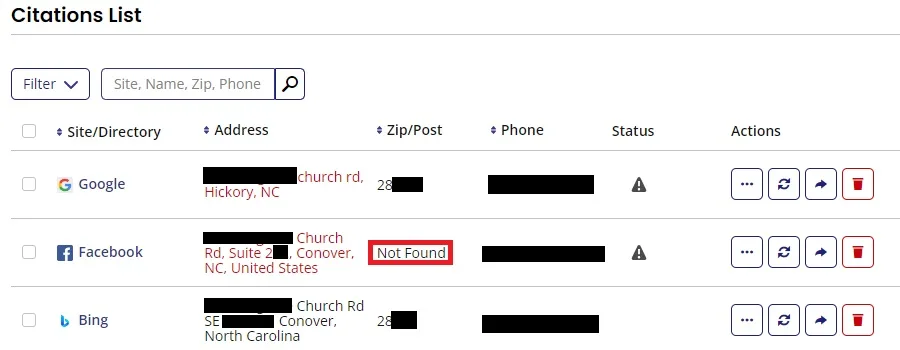
To make things even easier, the Citations List highlights any NAP inconsistencies in red.
For the sake of privacy, I’ve redacted a lot of information in the screenshot above, but you can clearly see there are discrepancies in the address information.
In particular, both Google and Facebook list the street name as Church Road, though Bing lists it as Church Road SE, which is a different street.
The two also list the same business in two different cities.
Sure, if you look on a map, you’ll see that they’re both close to each other, but if clients go to Church Road, Hickory, they’re going to end up in a very different place than Church Road, Conover.
Armed with these literal red flags, all you’re left to do is visit the out-of-date profiles and make the appropriate updates.
BrightLocal comes with a 14-day free trial. Paid plans range from $35 (£27.47 per month)
2. SEMRush Local Listing Management
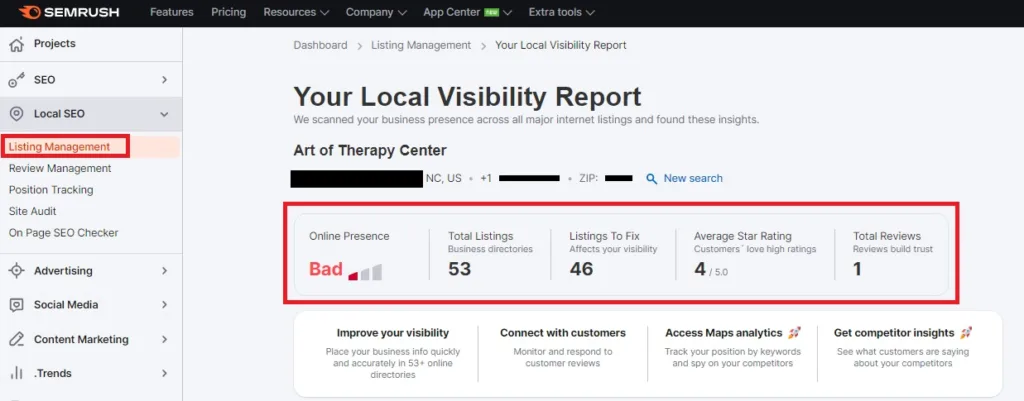
SEMRush is my all-time favorite SEO tool. I use it for everything from doing keyword research to tracking the number of backlinks pointing to my site.
Even though I found BrightLocal did a better job for this particular task, SEMRush’s trademark speed, data accuracy, and user-friendliness are all present and correct within its local listing management tool.
Even using the free version of SEMrush, running a search for your business almost immediately returns a complete Local Visibility Report.
At the head of this review, you’ll find a basic overview of your online presence, including:
- An overall score
- Your total number of listings
- How many listings have NAP errors
- Average customer review ratings.
Scroll down, and the platform lists all inconsistencies in your NAP information, making it easy to make changes.
Meanwhile, paid SEMRush subscribers can also connect their online profiles to the platform to manage all of your revisions in one place.
- SEMRush is available on a free plan with limited features. Paid plans start from $129.95 (£101.94) per month.
3. Moz Local Listing Checker
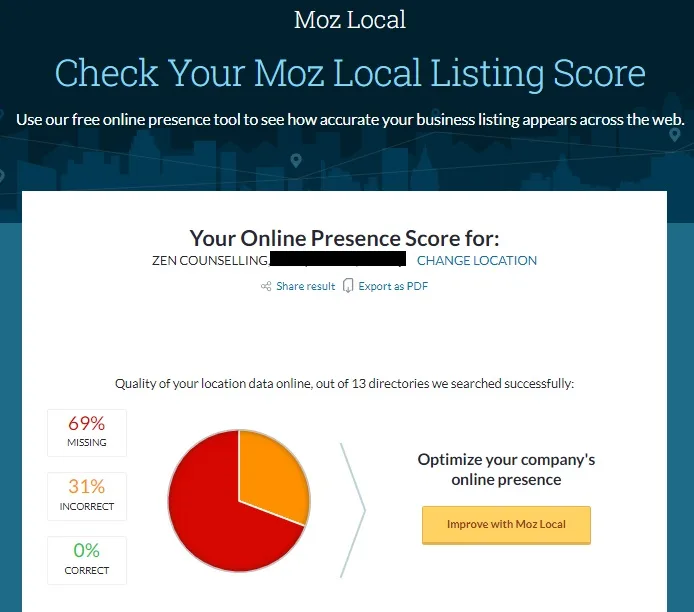
The advantage of using Moz Local Listing Checker over others on this list is that it’s pretty fast.
However, it’s also pretty basic.
Type in the name and address of your business, and you’ll receive a visual overview of your current online profiles, including how many feature correct and incorrect information.
The best thing about this one is that it does a good job of revealing platforms where your business doesn’t yet have a presence.
The fact that it’s fast and free makes it a worthwhile starting point if you simply want to figure out the extent of your NAP inconsistencies, though you really need the paid Moz Local plan to get any real value from it.
- Moz Local plans start from $14/£14 per month. There is no free trial available, though you can use the Local Listing checker for free.
Do I Need to Share My Business Address Online if I Work From Home?
If your therapy practice is based at your private home, you don’t need to share your address in your online profiles.
Although some platforms (such as Google My Business) will require your address as a means of verification, you’re not obligated to make this information public.
In fact, it’s better that you don’t.
So, what should you do instead?
Ideally, the best option is to share just enough location details to help local people find you in search results without giving away your whole address.
For example, rather than sharing your street, zipcode, and everything in between, you simply publicize your town, state, or general region.
That way, you can still appear in search results when a potential client looks for counselors in Philadelphia, Pennsylvania, without telling the whole world that you live at 123 RockyBalboa Road, Philadelphia.
Of course, if you only provide online therapy, physical address details aren’t really necessary, but that doesn’t mean you shouldn’t include them.
Posting your business online without any location details may lead potential clients to doubt your credibility. After all, it’s said that customers trust a real address over a PO Box address, so you can probably imagine how you might be perceived if you appear to have no address at all.
In this scenario, I recommend using a company like PostScanMail to set up a virtual business address close to where you live.
How Nap Consistency Affects Your Online Impact: Recap and Next Steps
I hope this guide has given you a better understanding of what NAP consistency means and how it impacts your ability to attract new clients from the web.
To sum up, here’s a recap of the key lessons from today’s guide:
- NAP Consistency is about keeping your business information complete and accurate across the web – Including not just Name, Address, and Telephone (NAP) details, but other useful information such as web address, email, and business hours.
- Inconsistent NAP information can negatively affect your therapy practice – Not only can it hinder your local SEO efforts, but also confuse potential clients and damage your credibility.
- Maintaining accurate business listings is easier with software – Use tools like BrightLocal to conduct a thorough NAP audit and keep all your online profiles consistent and up-to-date.
Once you’ve conducted your NAP audit, check out other recommended marketing tools for therapists to help you take your practice to the next level.
Enjoyed this post? Get more marketing advice for therapists every week by following Therapist Marketing Tips on Facebook.




